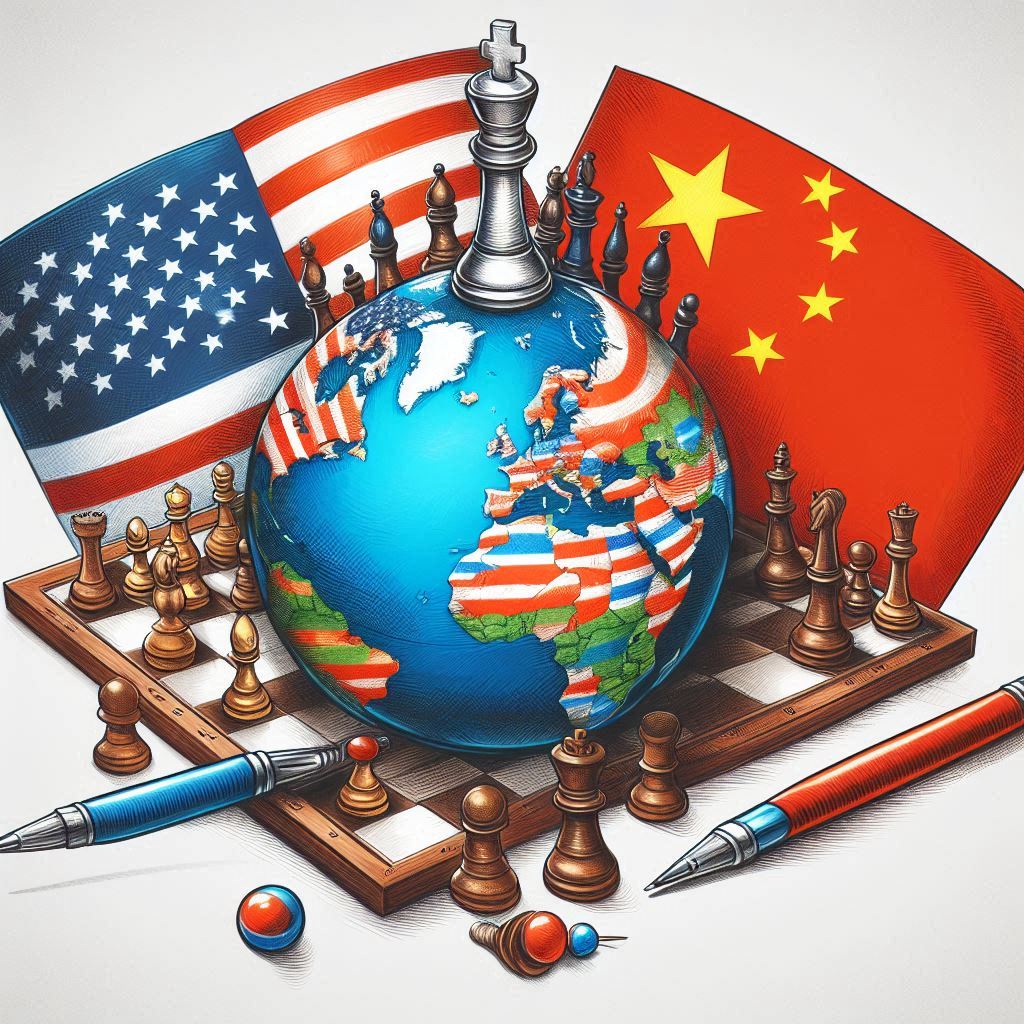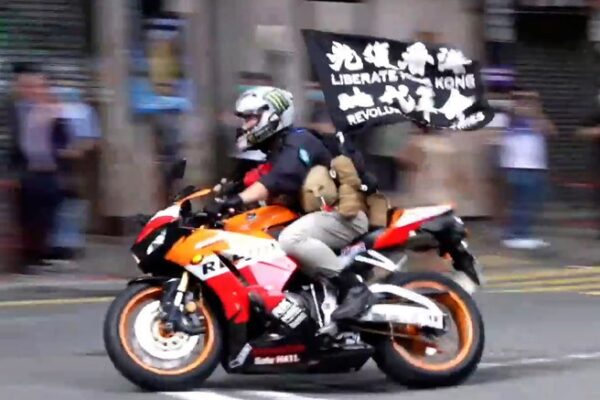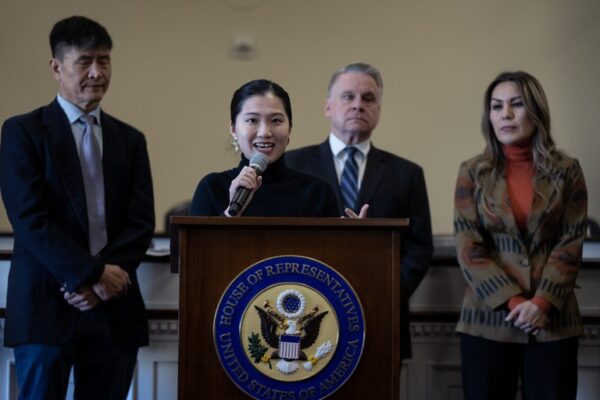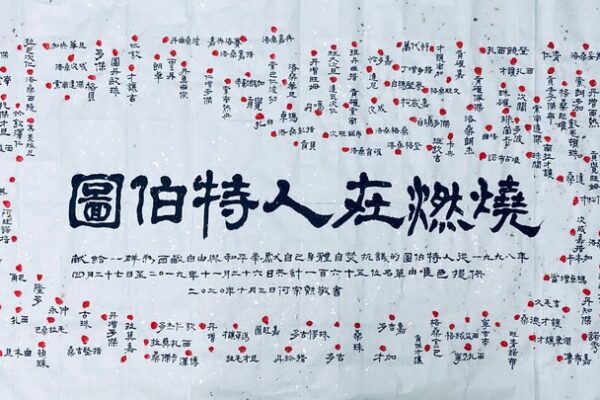
Category: East Asia

Ancient theatrical tradition falls on hard times in crisis-torn Myanmar
For 145 years, the Myanmar city of Pyapon has marked the end of the rainy season with a performance of the ancient Indian epic poem Ramayana–never halting the annual ritual, even during Japanese occupation in World War II, a major uprising against harsh military rule and a catastrophic cyclone. These days, however, the dancers who have for seven generations made the Ayeyarwady River delta region city famous for performances of the Burmese version of the Sanskrit epic fear they may be the last of their kind in a country plunged into economic hardship and political turmoil in the wake of the COVID-19 pandemic and a 2021 military coup. “COVID health problems arise. Political crises arise. The days of performance are getting shorter,” said Zaw Oo, chairman of the Pyapon Ramayana troupe. “Funds are scarce. Jobs are scarce. Moreover, foreign culture infiltrates. It is really hard to preserve it so it won’t disappear,” he told RFA Burmese. People gather to watch Ramayana, a traditional drama being performed. (RFA photo) The 53-year-old father of two is a national gold medalist in performing as Dathagiri, the ten-headed chief antagonist in the Ramayana epic poem and the subject of worship in both Hindu and Buddhist temples in India and across Southeast Asia. “The main reason for performing is for safety,” Zaw Woo said of the belief that to keep Pyapon safe, the annual reading of the play must not be broken. “If we cannot perform it, we have to serve meals for Dathagiri as a token offering every year,” he told RFA. “We have to perform it – even if it’s an hour or a verse – to keep the tradition.” The Pyapon dance troupe has made modifications to tradition to keep people in seats for a lengthy poem that in the original Sanskrit has 24,000 verses. The Burmese Ramayana’s 94 chapters used to take up to 45 days to perform. (RFA photo) Overseas tour The Burmese version of the Ramayana used to require 45 days to perform, but the troupe trimmed it back – to nine days and nine nights. During the pandemic and following the February 2021 military takeover, the dance became a one-day, closed-door performance at Pyapon’s Shwe Nat Gu Pagoda. Last year, they put on the Ramayana for one day at the Rama theater, but this year, it ran for three days at the end of November. The truncated version of Myanmar’s national epic got mixed reviews, even from sympathetic fans. “In the past, I liked watching it. Watching all nine episodes. Now it’s just one afternoon,” said a 65-year-old woman named Myint. “I’m just watching it to slake my desire.” “Now, young people don’t dare to go out, so it’s not as crowded as it used to.” added Myint. The Ramayana dates as far back as 7th to 4th centuries BCE in what is now northwestern India, and became a major cultural and moral influence on Hinduism and Buddhism. Versions of the story of Prince Rama are found across South Asia and Southeast Asia, from the Maldives to the Philippines. Children with Thanaka, a light-yellow cosmetic paste in their faces, gather to watch Ramayana being performed. (RFA photo) She told RFA that fears of instability in Myanmar since the coup has taken away her enjoyment in going to the theater. The Pyapon dancers – proud amateurs with day jobs – are hoping their fame in Myanmar can translate into international support for the struggling troupe. In October they were invited to perform the Ramayana at the Indian embassy in Yangon, 75 miles (120 kilometers), which led to plans to put on the drama in India, Nepal and Indonesia, said Zaw Woo. “While he was giving us certificates of honor, the Indian ambassador – together with diplomats from the Nepali and Indonesian embassies – promised that he would do everything possible to help our Pyapon Ramayana troupe to visit these countries to perform the drama,” he said. Dancing trumps job Passion for performing remains high in Pyapon, despite the gloom and doom. A Ramayanaya performer backstage. The Ramayana was performed continuously even during World War II under Japanese occupation. (RFA photo) “I may not have eaten a meal, but if I’m performing the drama, I’m satisfied,” said Wai Phyo Aung, who is playing the role of Lakshmana, younger brother of Rama and has been dancing in the Ramayana troupe for 15 of his 34 years. He is the first in his family to perform after becoming fascinated with Ramayana dancing as a schoolboy. “I used to work for a company, and I lost my job again and again after performing nine nights,” he told RFA. “So, in order not to lose my next job, I became a taxi driver.” Sein Myint, the 77-year-old father of Zaw Woo, winner of three gold medals in a long dancing career, urges people to help keep the Pyapon Ramayana troupe dancing. “Some people think we are performing the drama because we are receiving payments,” he said. “We’re not. We’re manual laborers. If anyone offers to help us, we’ll accept it at any time.” Translated by Htin Aung Kyaw. Edited by Paul Eckert.
Tibetan activist and former political prisoner dies at 54
Kunchok Lodoe, a Tibetan activist who was sentenced to 13 years in prison for protesting against the Chinese government, died Monday at the age of 54, Radio Free Asia has learned. Lodoe’s friends and fellow activists reported that he was in overall good health before his death on Dec. 11. “Kunchok Lodoe was doing well the day before he died, so his death was very sudden,” former political prisoner Ngawang Sangdrol told RFA. “Many political prisoners die in their 40s, mostly because of the severe torture they go through while in the prison.” Lodoe was sentenced to 13 years at Drapchi Prison in Lhasa, Tibet’s largest detention center. But after being subjected to “tremendous physical torture,” he began experiencing serious health issues related to his liver and was released in 1995 to undergo medical treatment, Sangdrol said. Sangdrol, a childhood friend of Lodoe who now resides in the United States, was imprisoned alongside him at Drapchi Prison in Lhasa. Lodoe, who was born in Meldrogunkar county near Lhasa, was first arrested in 1992 for participating in a protest against the Chinese government. “Kunchok Lodoe, along with four other Tibetans, took to the streets on June 30, 1992, to protest the Chinese government,” Sangdrol recounted. “They unfurled the Tibetan flag and shouted ‘free Tibet’ outside of the building where local Chinese leaders were holding a meeting.” “Five of us, including Kunchok Lodoe, shouted slogans such as ‘Long live the Dalai Lama,’ ‘Free Tibet,’ and ‘End China’s one-child policy,’” recounted Sonam Dorjee, a Tibetan activist who protested alongside Lodoe in 1992. “During that time, the exploitation of Tibet’s natural resources by the Chinese government was at its peak, so we also shouted, ‘Stop exploiting our natural resources!’ We even took down a Chinese flag outside the building and unfurled our Tibetan flag. That’s why we were imprisoned.” “We were beaten a lot during our time in prison, especially our chests and stomachs,” Dorjee, who now resides in Switzerland, told RFA. “I remember Kunchok had health issues with his liver that made him so weak and sick all the time.” Jamphel Monlam, a former political prisoner and researcher at the Tibetan Centre for Human Rights and Democracy in Dharamsala, expressed his respect for Lodoe’s activism. “Kunchok Lodoe and the four other Tibetans arrested in 1992 [come from simple backgrounds] and their courage to protest in front of the Chinese authorities is commendable,” he told RFA. “I know they went through both physical and mental torture while in prison. It’s very sad to learn that [Lodoe] is no more.” Translated by Tenzin Dickyi. Edited by Claire McCrea and Malcolm Foster.
Third time a charm?
Scores of high-level officials and experts from multiple countries have nominated jailed Uyghur academic Ilham Tohti to receive the 2024 Nobel Peace Prize. Tohti, 53, was shortlisted for the Peace Prize in 2020 and 2023. He is serving a life sentence, with no contact with his family for years, on separatism charges for what supporters say were efforts to promote peaceful interethnic dialogue between Uyghurs and China’s Han Chinese majority.

Motorcycle protester appears in ‘confessional’ video
A man jailed for nine years for riding a motorcycle carrying a banned slogan of the 2019 protest movement has appeared in another mainland Chinese-style televised “confession,” as part of a series of propaganda films made by the Hong Kong police in praise of a harsh security law. “I wasn’t thinking straight. I was under the influence of the atmosphere that prevailed at that time,” Tong Ying-kit says in the police-made video published Dec. 12 to the website of Hong Kong broadcaster TVB. “It felt as if there was no way to resolve issues other than through violence,” says Tong, who appears in prison uniform with his back to the camera. A narrator intones: “Tong Ying-kit became the first person to be prosecuted under the National Security Law for ‘inciting others to secession’ and ‘terrorism.’ He was just 23 years old at the time.” Motorcyclist Tong Ying-kit carries a flag reading “Free Hong Kong, revolution now!” during a protest in Hong Kong, July 1, 2020. (Cable TV Hong Kong via AP) The video is the second “confession” by a political prisoner to air in Hong Kong, and comes amid a citywide crackdown on political opposition and public criticism of the authorities under the National Security Law, which Beijing imposed in 2020 in response to protests the year before. Last week, Tsang Chi-kin, who was jailed for “rioting” after being shot in the chest by police during the 2019 protest movement, made a similar video claiming that he too was drawn into the movement as emotions ran high. “#HongKong police & pro-CCP TV station TVB have broadcast a #propaganda video of Tong Ying-kit, the 1st person prosecuted under the national security law,” the U.S.-based Hong Kong Democracy Council said via its account on X, formerly Twitter. “This is the 2nd show using a #PoliticalPrisoner. It is reprehensible coercion similar to CCP-style forced televised confession,” the council said. ‘Free Hong Kong’ banner Tong was jailed in July 2021 after much of the case was spent deciding whether the banned protest slogan on his banner – “Free Hong Kong, revolution now!” – could be considered an incitement to secession, or independence for the city. The judges said Tong’s offense was “serious” and therefore deserving of a jail term of between five and 10 years, but said his call for “secession” hadn’t come with a plan attached, and that he had committed the offense alone. They said that while the police officers who brought him and his motorbike down weren’t seriously injured, Tong’s actions were pre-planned, and his bike was a “lethal weapon.” Tong Ying-kit arrives at court in Hong Kong. July 6, 2020. (Vincent Yu/AP) “These were very serious criminal charges that could have resulted in life imprisonment,” Tong says in the video. The narrator highlights how much he misses his family, adding that he has enrolled in a rehabilitation program to help him “manage his emotions,” and is studying for a high-school qualification. The ends with footage of Tong handling and saluting the flag of the People’s Republic of China in a formal flag-raising ceremony of the kind now commonly seen in schools and other public institutions in Hong Kong. Political prisoner honored The video was released as another prominent political prisoner – barrister and former 1989 Tiananmen massacre vigil organizer Chow Hang-tung – was honored by two European governments with a human rights award. Chow was announced on International Human Rights Day as one of 12 activists, journalists and lawyers “working to defend the inalienable rights of each and every human being” being presented with the Franco-German Prize for Human Rights and the Rule of Law. “The prizewinners … stand up for those whose voices would often not be heard without them, such as women, refugees, LGBTIQ+ people and prisoners,” according to the award website. Chow Hang-tung, a barrister and former 1989 Tiananmen massacre vigil organizer in Hong Kong, poses after an interview in Hong Kong, May 24, 2021. (Vincent Yu/AP) “They are committed to the cause of justice, political participation and unbiased reporting in the media, often risking their own freedom, frequently even their lives, under the most difficult conditions,” it said. The Hong Kong government hit out at the foreign affairs ministries of France and Germany over the award, expressing its “strong disapproval.” “Chow Hang-tung is facing a criminal prosecution of ‘incitement to subversion’ and the case has been committed to the Court of First Instance of the High Court awaiting trial,” a spokesman said. “The judicial proceedings of the case are still ongoing, but the ministries of foreign affairs of France and Germany have issued the so-called prize … in the name of ‘human rights’ and the ‘rule of law’.” Authorities in Hong Kong will continue to “effectively prevent, suppress and punish acts and activities that endanger national security,” the spokesman said. Last month, Chow, who has been behind bars since September 2021, was honored with Council of Bars and Law Societies of Europe human rights awards, alongside Chinese rights attorneys Xu Zhiyong and Ding Jiaxi, who were jailed in April for attending a 2019 gathering of dissidents in the southeastern city of Xiamen. Translated with additional reporting by Luisetta Mudie. Edited by Malcolm Foster.

Pro-Beijing ‘thugs’ tormented Xi protesters, activists say
China’s embassy and consulates in the United States bused hundreds of pro-Beijing counter-protesters to San Francisco last month to violently suppress demonstrations against Chinese President Xi Jinping’s visit, activists and a U.S. lawmaker said on Tuesday. In many cases, the San Francisco Police Department stood idly by while the assaults were occurring, according to the activists. Speaking at a media event organized by the Congressional-Executive Commission on China, the Tibetan, Uyghur, Chinese and Hong Konger activists said the pro-Beijing counter-protesters constantly harassed them and even assaulted them during Xi’s four-day visit to the city. Xi was in San Francisco for the Asia-Pacific Economic Cooperation summit, during which he also met U.S. President Joe Biden in what the White House promoted as a chance for warmer U.S.-China ties. On the streets of San Francisco, things were far less cordial, with pro-Beijing counter-protesters harassing any anti-Xi voices across the four days of the summit and beating many who did not flee, said Anna Kwok, executive director of the Hong Kong Democracy Council. What she witnessed made her “heart ache,” she said, and had changed her mind about the scope of trans-national repression in America and, therefore, the safety of speaking out on U.S. soil. Anna Kwok, executive director of Hong Kong Democracy Council, speaks during an event in Washington, D.C., to present evidence of violence and harassment by pro-Chinese Communist Party groups at the APEC Leaders’ Summit in San Francisco in Nov. 2023. (Gemunu Amarasinghe/RFA) “I thought the United States was a safe haven for me to continue my advocacy work, but last month proved me all wrong,” Kwok said. “I’m very sorry to say that I no longer feel safe to be in the United States, and I no longer feel safe to continue doing my advocacy work.” “I urge authorities to conduct a thorough and extensive investigation into the violence waged against us,” she said. “Congress should also pass policies to combat transnational repression.” ‘I thought we were safe’ Wearing a black eye patch, Kaiyu Zhang said he fled from China to the United States earlier this year to escape political persecution, and decided to exercise his newfound freedoms by joining a protest against Xi’s arrival at San Francisco International Airport on Nov. 14. After parking his car at a Costco about 10 minutes’ walk away from the protest, he said, about “a dozen young Chinese men” started following him – likely, he said, after hearing him speak Cantonese to a friend, which caused them to offer an expletive-ridden rant about Hong Kong. “I thought we were safe in America,” Zhang said. So he replied with a similar collection of expletives about China’s soon-to-arrive president. The next thing he knew, he recalled, he was thrown to the ground and was being beaten “violently” by the men. Another group of men arrived to join in at some point, he said, and he then lost consciousness. He later posted a video of the men onto the X social media platform. “It was a well-organized and well-coordinated assault,” Zhang said. “The groups of thugs were wearing red headbands and red scarves to identify fellow thug members, and to coordinate with each other.” Like Kwok, Zhang said his time in San Francisco opened his eyes. He had once been surprised to meet other Chinese immigrants who still counsel others against publicly criticizing the Chinese Communist Party, even while in the United States. “I was once angry with them,” he said. “Now I understand why.” Police inaction The activists spoke of the pervasiveness of the harassment. Pema Doma, the executive director of Students for a Free Tibet, estimated about two dozen young Tibetan-Americans were assaulted by the pro-CCP counter-protesters during APEC. Doma said the “thugs” appeared to be targeting young protesters – including following them home on the subway from protests – in order to scare the groups into disbanding or ending the anti-Xi protests. “Chinese CCP agents were targeting individuals and picking them off from the group as if they were prey,” she said. “I was very proud that night when the student activists, some of them as young as 16 … decided they will stay at the protest regardless of the threats.” The counter-protesters worked together to use large Chinese flags both as weapons – leveraging the poles to beat their targets – as well as covers to hide their violent activities from nearby police, she said. In one particularly bad case, Doma recounted, a Tibetan-American mother alerted police to her son being beaten “about 50 feet away,” but they refused to intervene because it was obscured by the flags. A woman protesting Chinese President Xi Jinping’s arrival at a hotel in downtown San Francisco on Nov. 14 is surrounded by pro-Beijing counter-protesters bearing large flags (Alex Willemyns/RFA) Instead, she said, police cautioned her not to stay away. “I have never felt such disappointment as when the San Francisco Police Department told me ‘We cannot go there,’ and they actually restrained the mother from going to her own child,” she said. “I have never felt so powerless as a Tibetan-American person.” RFA reporters in San Francisco last month witnessed a separate incident where a protester outside the Chinese president’s downtown hotel was surrounded by a group bearing large flags before being thrown to the ground and stomped on as police stood nearby. Calls for investigation Both the San Francisco Police Department and the Chinese Embassy in Washington did not respond to requests for comment from RFA. Rep. Chris Smith, a Republican from New Jersey who serves as a co-chair of the Congressional-Executive Commission on China, told the news conference that he believed police on the scene were acting on orders “from above” and said an investigation was warranted. “These claims, as well as the non-responsiveness of the San Francisco Police Department … must be investigated, as this marks an escalation of flagrant transnational repression on United States soil,” Smith said. Rep. Christopher Smith (R-NJ), chair of Congressional-Executive Commission on China, speaks during…

Jailed Uyghur academic Ilham Tohti nominated for Nobel Peace Prize
More than 180 high-level officials and experts have nominated jailed Uyghur academic and blogger Ilham Tohti to receive the 2024 Nobel Peace Prize, citing his role as “the true symbol of the Uyghur people’s fight for freedom” under Chinese rule in Xinjiang. The nomination includes signatures from ministers, parliamentarians, university rectors and professors from countries including Canada, Japan, Rwanda, Australia, Paraguay, Turkey and France – a “broad international coalition” which initiative leaders Vanessa Frangville of the Free University of Brussels, Belgium, and Belgian MP Samuel Cogolati believe will bolster the 53-year-old Tohti’s chances at securing the award. “At a time when the U.N. is denouncing ‘crimes against humanity’ in Xinjiang, it is our duty to break the silence towards Xi Jinping’s totalitarian regime and support the true symbol of the Uyghur people’s fight for freedom,” they said in a statement on Monday. Supporters nominated Tohti days after the anniversary of a Dec. 9, 2021, ruling by an independent Uyghur Tribunal – composed of international legal experts, scholars, and NGO representatives – that China has perpetrated genocide against the Uyghur people. An outspoken economics professor who regularly highlighted the religious and cultural persecution of the mostly Muslim Uyghur ethnic minority in northwest China’s Xinjiang Uyghur Autonomous Region, Tohti was sentenced to life in prison on Sept. 23, 2014, following a two-day show trial on charges of promoting separatism. The court decision cited Tohti’s criticism of Beijing’s ethnic policies, his interviews with overseas media outlets, and his work founding and running the Chinese-language website Uighurbiz.net, which was shut down by Chinese authorities in 2014. But while Beijing has denounced the academic as a “separatist,” others have highlighted what they say is his commitment to peaceful interethnic dialogue between members of his ethnic group and China’s Han Chinese majority. Tohti was shortlisted for the Peace Prize in 2020 and 2023. Supporters of this year’s nomination include Kenneth Roth, former director of Human Rights Watch and co-winner of the Nobel Peace Prize in 1997, and U.S. Congressman Chris Smith, who is also chair of the Congressional-Executive Commission on China. Two members of the Belgian federal government, the speaker of the Belgian senate, two political party leaders from France, the first member of Japan’s parliament of Uyghur origin, and a member of the U.K. House of Lords also lent their names to the nomination. ‘Unprecedented’ nomination In an interview with RFA Uyghur, Cogolati called the initiative to nominate Tohti “unprecedented” because of the breadth of political views, backgrounds and global perspectives represented. “This time, we really decided to mark the occasion by joining forces between the academic and political worlds,” he said. “Ilham Tohti has always been cited as a possible favorite for the next Nobel Peace Prize. This time, what’s really different is that we were able to join forces between not only members of parliament all around the world, but also with universities, with rectors, university directors and professors.” From left: Enver Can, founder of İlham Tohti Initiative, Jewher Ilham, Ilham Tohti’s daughter, Belgian MP Samuel Cogolati and Free University of Brussels professor Vanessa Fangville are seen at a press conference on Monday, Dec. 11, 2023. (Samuel Cogolati) Cogolati said that the international community has a “duty to raise their voice and to condemn the atrocities altogether” when China is working to “silence public intellectuals like Ilham Tohti.” “He’s really a symbol of the fight of the people for freedom, but also for reconciliation, for peace and dialogue with Chinese people,” he said. “So that’s why, for us, it’s not only a fight for the recognition of the amazing academic talents and of the work of Ilham Tohti. But it is also a recognition of the fight of all Uyghurs around the world who are being persecuted by the totalitarian regime of [Chinese President] Xi Jinping.” The Belgian lawmaker said the outsize influence China can exert on international institutions was not lost on him, noting that in 2010, after Norway’s Nobel committee awarded the Peace Prize to then-jailed Chinese democracy activist Liu Xiaobo, Beijing imposed trade sanctions on Oslo. Liu died from late-stage liver cancer in 2017 while serving an 11-year jail term for subversion. “We really recognize the implications and the impact,” he said. “But what we say is that peace is more important. Life, dignity, and freedom for your people are more important.” Withstanding Chinese pressure Tohti’s daughter, Jewher Ilham, told RFA that a win for her father next year would “send a message to the Chinese government that my father has not been forgotten” and force Beijing to demonstrate proof of life for the long-jailed scholar. Additionally, she said, awarding Tohti the Peace Prize would “prove to the Chinese government and the international community that the Nobel Peace Committee is a separate entity that would not be influenced by political pressure – whether it is from China or Norway.” Human Rights Watch China Director Sophie Richardson agreed that the Nobel Committee is “capable of withstanding [the] kind of pressure” China exerted on it after Liu’s win. “When Liu Xiabo won the Nobel Peace Prize. I think it was understood and felt not just as a win for him, but indeed for peaceful critics of the Chinese government all across the country and the world,” she said. “And I think it would probably have the same effect, not just for Uyghurs, but for all people who have suffered oppression at the hands of the Chinese government.” “It would be an enormous boost to Uyghurs worldwide to have their community and somebody who’s a longtime leader of it be recognized for his extraordinary contributions to peaceful debate, to the idea of equality, to the preservation of a distinct Uyghur identity.” Tohti has received more than 10 international human rights awards since his sentencing, including the Martin Ennals Award for Human Rights Defenders in 2016 and the Sakharov Award for “Freedom of Thought” in 2019. Edited by Joshua Lipes and Malcolm Foster.

Taiwan calligraphy exhibit honors Tibetans who self-immolated
On Sunday, Tibetans around the world will be protesting outside Chinese embassies around the world to mark International Human Rights Day. There is no Chinese Embassy in democratic Taiwan, so the Dalai Lama Foundation will exhibit 166 works of calligraphy by Ho Tsung-hsun, with prayers and chants from five Buddhist teachers honoring the “heroes and martyrs” of the Tibetan resistance movement instead. The exhibit – titled “Those Who Give Fearlessly” – will honor 166 Tibetans inside and outside China who have set themselves on fire as an act of resistance to Chinese Communist Party rule, and in pursuit of freedom, Ho told Radio Free Asia in a recent interview. “I was very worried when I was doing this that people would think that I was encouraging self-immolation,” Ho said. “But these things happened – that’s a fact.” “You can’t erase an entire nationality from the historical record who have made such sacrifices in pursuit of their freedom,” he said. Ho made the exhibit not to advocate self-immolation, but to highlight the despair and helplessness of those who use it as a form of protest, he said. In 2020, Ho Tsung-hsun arranged the names of people who self-immolated around an outline of Tibet. (Provided by Ho Tsung-hsun) “Self-immolation is a last-ditch choice – there must be so much going on in people’s minds that we can’t understand,” he said. “166 self-immolations in the space of just 10 years is a shocking number.” “Cheng Nan-jung self-immolated right here in Taiwan, and we still see memorials to him here every year marking that day,” Ho said, in a reference to the 1989 self-immolation of the Taiwanese publisher, in a protest against the lack of free speech under authoritarian, one-party rule by the Kuomintang. Writing history Calligraphic inscriptions have been used since ancient times to record important events, whether on stone steles or on paper, Ho said. He hopes that his imitation of ancient scrolls will pay due respect to the people who burned in the ultimate act of self-sacrifice. Kelsang Gyaltsen, the Dalai Lama’s envoy to Taiwan, told Radio Free Asia he was moved by Ho’s tribute. “These Tibetans are heroes as we define them in Tibet,” he said. “The Chinese government demonizes them as insane, or claims they acted out of desperation due to family or economic disputes, but it’s not that. No.” “They sacrificed themselves for their country, and for their people.” Ho Tsung-hsun says Lobsang Phuntsok’s self-immolation death, the second to take place in Tibet, had a powerful effect as it occurred on Ho’s birthday. (Hsia Hsiao-Hwa) Kelsang Gyaltsen said the epithet, “Those who give fearlessly” is the highest level of almsgiving in the Buddhist tradition. “It means to give your life for a just cause,” he said. Many of those who set fire to themselves did so while shouting slogans or leaving statements calling for freedom for Tibetans, or for the return of its exiled spiritual leader, the Dalai Lama, and the protection of Tibetans’ Buddhist and cultural heritage. Some inscribed “Independence for Tibet” on their bodies, Kelsang Gyaltsen said. Anyone who claims that just speaking of the self-immolations means encouraging them is engaging in pro-Beijing “cognitive warfare,” he added. “Who is it who most wants to forget them? Who doesn’t want us to cherish or remember them? It’s the brutal Chinese Communist Party regime,” he said, calling for the anniversary of the first self-immolation – Feb. 27 – to be marked as “Tibetan Self-Immolation Day.” Art as protest Ho, who studied advertising and fine arts, started writing calligraphy in high school 40 years ago. His calligraphy has graced a number of protests over the last three decades in Taiwan, including environmental protection and anti-nuclear campaigns, educational reform movements and political activism. Ho Tsung-hsun placed images of the the tantric Buddhist deity Palden Lhamo, a protective warrior goddess also known as Shri Devi, and Nechung, a protective deity closely associated with the Dalai Lama, on his desk to help him complete the calligraphy for Namlha Tsering. (Provided by Ho Tsung-hsun) He has an abiding memory of one self-immolation – the second to take place in Tibet, in 2009 — in particular. “Lobsang Phuntsok, who was only 20 years old at the time, self-immolated on March 16, which happened to be my birthday,” Ho said. “From then onwards, it seemed as if our souls were connected, and that was when I started to pay attention and care about what was happening.” March 16 is also the anniversary of mass protests by Tibetans, including Buddhist monks and nuns in Ngaba, a Tibetan region of China’s southwestern province of Sichuan, in 2008, that were to be a turning point in the movement for a free Tibet. “I was shocked, saddened and outraged by each self-immolation, especially during the nearly 90 self-immolations that took place in 2012 – at their peak, we were seeing nearly one a week,” Ho said. Just thinking about the way Lobsang Phutsok died causes him pain to this day, he said. Ancient style Ho’s exhibit will display 166 records of self-immolation by Tibetans using paper and a calligraphic style that matches the style of ancient official records. Each piece is 34 cm long and 18.5 cm wide (13 x 7 inches). Each work shows the person’s name, place of birth, identity and age of self-immolation. Ho’s exhibit also has the blessing of the Tibetan government-in-exile’s envoy to Taiwan, who suggested he make sure Tibetans are the central subjects of the work, and add the ancient Tibetan place-names from when the region was a sovereign and independent country, alongside the modern place-names that are used under Chinese rule. One record reads: “Lobsang Tashi, a monk from Amdo in today’s Sichuan, was 24 years old when he set himself on fire on Feb. 27, 2009, to fight for the freedom of Tibetans.” Every one of the 166 self-immolators, who include elderly in their 80s, 16-year-old students, high-ranking Buddhist teachers, or Rinpoche, monks, nuns, students and women, is given equal…

Philippines, China accuse each other of ship ramming
Beijing and Manila traded accusations on Sunday morning with each side claiming its ships were harassed and rammed by the other. A Philippine spokesman said Philippine civilian supply vessels on a routine resupply and rotation mission to the BRP Sierra Madre – the old landing ship that Manila deliberately grounded on the Second Thomas Shoal to serve as an outpost in 1999 – were “harassed, blocked, and executed dangerous maneuvers on” by the Chinese coast guard and maritime militia vessels. Jay Tarriela, the Philippine coast guard’s spokesperson, posted on the social media site X a statement by the National Task Force for the West Philippine Sea, the part of the South China Sea under Manila’s jurisdiction, saying that the resupply boat Unaizah Mae 1 (UM1) was rammed by the Chinese coast guard ship CCG 21556. The Chinese coast guard earlier issued a statement saying that at 06:39 a.m. the UM1 “ignored CCG repeated stern warnings, violated the COLREGs (Convention on the International Regulations for Preventing Collisions at Sea), swerved in an unprofessional and dangerous manner, and deliberately collided into the CCG boat 21556, resulting in scratches, for which the Philippines is fully responsible.” Ship ramming is generally considered an act of violence and could cause serious damage to vessels, as well as injuries to the crew on board. There have been instances of ship ramming in the South China Sea but no state has ever officially sanctioned this dangerous tactic. The previous time Manila accused Chinese vessels of ramming its ships was on Oct. 22, also in the waters off the Second Thomas Shoal, known by Filippinos as Ayungin Shoal and by the Chinese as Ren’ai Jiao. China denied it. The Philippines afterwards summoned the Chinese ambassador and filed a diplomatic protest against China’s action. The United States also expressed concern, issuing a warning that Washington is obligated to defend the Philippines under a 1951 Mutual Defense Treaty if Filipino forces, ships and aircraft come under armed attack, including “those of its coast guard — anywhere in the South China Sea.” Cat and mouse Manila and Beijing have been playing cat and mouse around the Second Thomas Shoal. The Philippines is making regular resupply missions to the troops stationed on the Sierra Madre and the Chinese coast guard has been trying to prevent them. The statement from the Philippine National Task Force said that on Sunday morning “CCG vessel 5204 deployed a water cannon against the Philippine supply vessels causing severe damage to M/L [motor launch] Kalavaan’s engines, disabling the vessel and seriously endangering the lives of its crew.” It also showed photos of the Kalavaan being water cannoned and then towed to port. “We condemn, once again, China’s latest unprovoked acts of coercion and dangerous maneuvers against a legitimate and routine Philippine rotation and resupply mission,” the statement said. “The Philippines will not be deterred from exercising our legal rights,” it added. Caption: Philippine supply boat Kalavaan being towed to port after being fired on with water cannons, Dec. 10, 2023. (Philippine Coast Guard) On Saturday, Manila accused the Chinese coast guard of deploying water cannons, a floating barrier and painful sound blasts against boats ferrying supplies to Filipino fishermen in disputed waters near another shoal in the South China Sea. Vessels from Manila’s Bureau of Fisheries and Aquatic Resources were targeted by water cannon “at least eight times” as they attempted to deliver food and fuel to more than 30 Filipino fishing boats near Scarborough Shoal, said a statement by the National Task Force for the West Philippine Sea. The China Coast Guard responded by saying it had used “control measures in accordance with the law” against the Philippine boats as they “intruded” into the waters adjacent to the island. Analysts say that Manila has embarked on a tactic of “assertive transparency” in reporting incidents in disputed waters. “Although the term was coined this year, the practice of assertive transparency has been used ever since people dealt with gray zone tactics,” said Alexander Vuving, a professor at the Daniel K. Inouye Asia-Pacific Center for Security Studies in Hawaii. Gray zone activities are not explicit acts of war but can be harmful to a nation’s security. “For example, during the 2014 oil rig crisis between China and Vietnam, Hanoi ferried international journalists to the site of the oil rig confrontation so they could shed maximum light on the ‘gray zone’.” “This was assertive transparency in practice, although nobody used that term to describe the practice in 2014,” the political analyst told RFA. “This practice has proven to be effective,” said Vuving, adding “The other key was perseverance.” Jason Gutierrez in Manila contributed to this article. Edited by Mike Firn.
Police out in force during Lhasa religious festival
Chinese police were out in force during a major religious festival in Tibet’s regional capital of Lhasa on Thursday, residents told Radio Free Asia. It was the latest effort by China to suppress Tibetan religious and cultural expressions by sending a large police force to religious gatherings to surveil attendees. Marked by displays of butter lamps and candles, the Gaden Ngamchoe festival commemorates the death of Je Tsongkhapa, the founder of the Gelukpa school of Tibetan Buddhism, a revered 14th century scholar. It is observed on the 25th day of the 10th month of the Tibetan calendar, which falls on Dec. 7 this year. But police in Lhasa prevented followers from gathering in large numbers and restricted the number of those trying to go on a pilgrimage to the Jokang Temple and Potala Palace, a resident there told RFA Tibetan on condition of anonymity for security reasons. “The Chinese government has deployed police in great numbers, and checkpoints to screen and restrict the mass public gatherings to observe the Ganden Ngachoe prayer offerings in Lhasa,” the resident said. “Drones are used to track people’s movement.” In video footage RFA obtained from a trusted source, a heavy police presence can be seen all around the Tsuglakhang Temple. The police use high beam flashlights to disperse the crowds around the temple and tell the devotees to keep moving. The enhanced surveillance came without warning, another resident said. “Without any prior announcement, the Chinese authorities are distressing devotees from entering Tsuglakhang Temple on this auspicious day,” the second resident said. “There are so many police deployed all around Tsuglakhang and police holding guns can also seen above the temple.” Though they were allowed to enter the temples, the police were there to ensure that the gatherings did not grow to be too big, the second resident said. “They are dispersing the devotees in sections and screening us and checking our phones at the checkpoints.” Translated by Tenzin Dickyi. Edited by Eugene Whong.
Vietnam repatriates more than 1,000 of its citizens from Myanmar
Updated Dec. 7, 2023, 5:25 p.m. ET. Vietnam this week flew home just over 1,000 of its citizens who were stranded in wartorn Myanmar, Hanoi’s Ministry of Foreign Affairs announced Thursday. On Monday, Tuesday and Wednesday, embassies and consulates in Myanmar organized nine flights to repatriate exactly 1,020 Vietnamese. Most of the repatriates were stranded in the northern areas of Shan State, where fighting between the junta and ethnic armed groups has intensified, with anti-junta forces making significant gains there in recent months. In the past, Vietnam has organized flights to evacuate its citizens from troubled areas in the world, including an effort during the COVID-19 pandemic that resulted in a massive scandal as officials skimmed off the top of repatriation funds and accepted bribes. The ministry stressed that expenses for all repatriation flights from Myanmar were paid by the Vietnamese government. RFA reported earlier this month that 166 Vietnamese citizens who had been trafficked to northern Myanmar but were rescued by authorities, remained stranded in a war zone. On Thursday, a mother of one of the 166 told RFA Vietnamese that her daughter had returned home that day to Phu Quoc Island City in Vietnam’s far southern Kien Giang province. “Everything was free of charge,” she said. “The government helped bring my daughter back to Moc Bai [the border gate between Vietnam and Cambodia], and my family paid for her travel from there to Phu Quoc. I am very, very happy.” She said the Vietnamese Embassy in Myanmar was very supportive, though the repatriation process was a bit complicated due to high volume. In August, RFA reported that 15-year-old Le Thi Tuong Vi was among a group of teenagers who were trafficked first to Laos, and were believed to be headed to either Myanmar or China. Vi was among those repatriated from Myanmar, her mother told RFA, but did not elaborate because her daughter is still recovering from her trip. But Trinh Khanh Hoang Anh, another teenager in the group, has yet to be repatriated, his father Trinh Huu Phuoc told RFA via text message. “There are 166 [Vietnamese] people who have been rescued and were living in a refugee camp of the military,” he said. “This morning, the kids were taken to Myanmar’s Border Gate 127 to verify information but there have been no results yet.” He said the Kien Giang provincial Department of Foreign Affairs advised the family that Anh’s paperwork has been completed but it has not yet arrived at the Vietnamese Embassy. According to the embassy, a number of Vietnamese still remain stranded in northern Myanmar due to ongoing fighting, state media reported. Translated by Anna Vu. Edited by Eugene Whong and Malcolm Foster. Update corrects the days that the flights were organized for.

